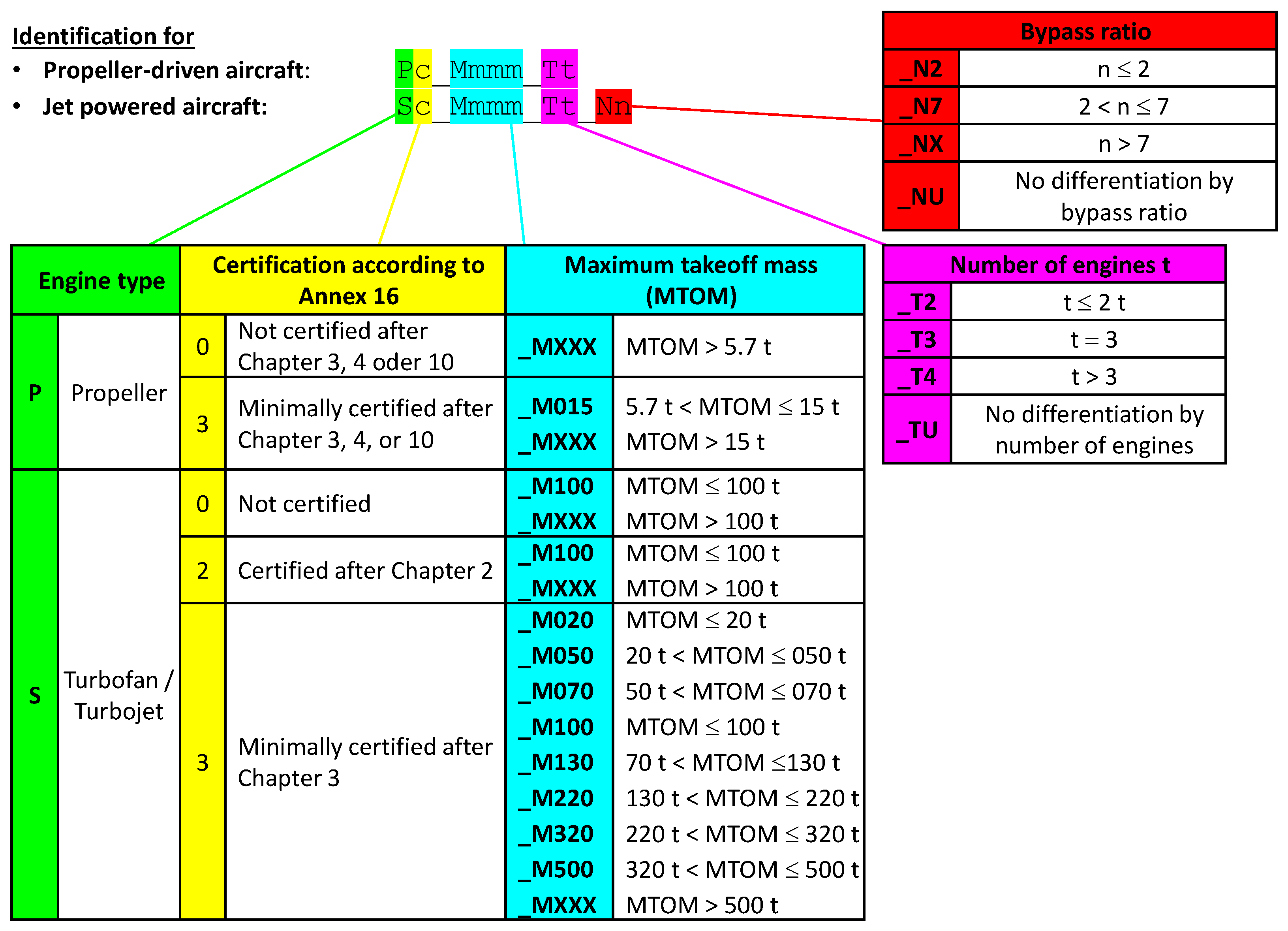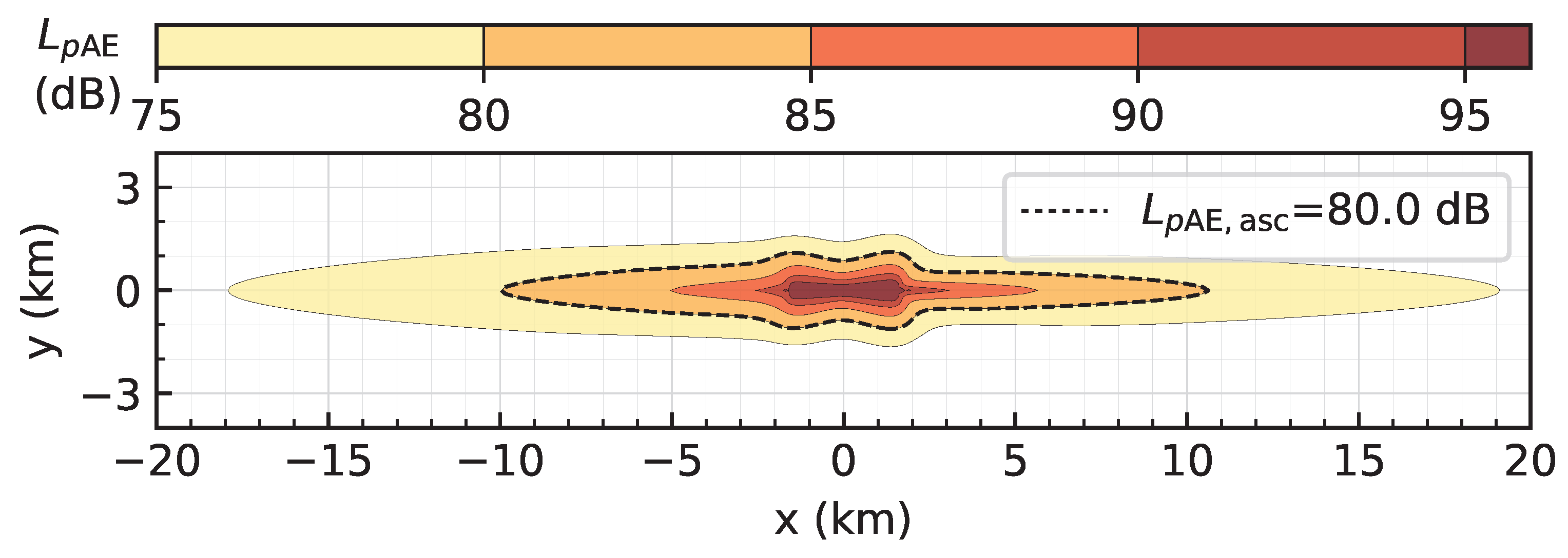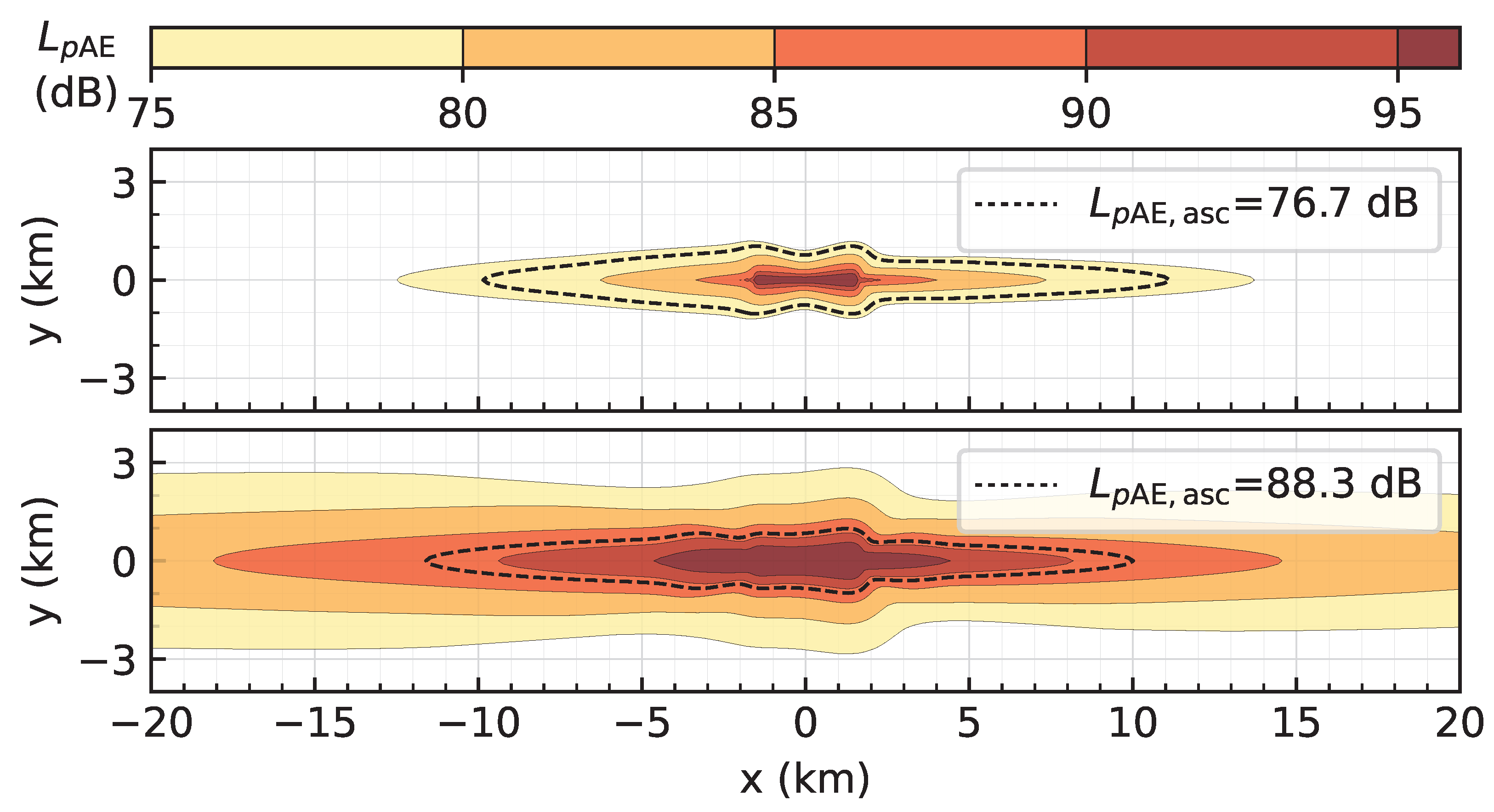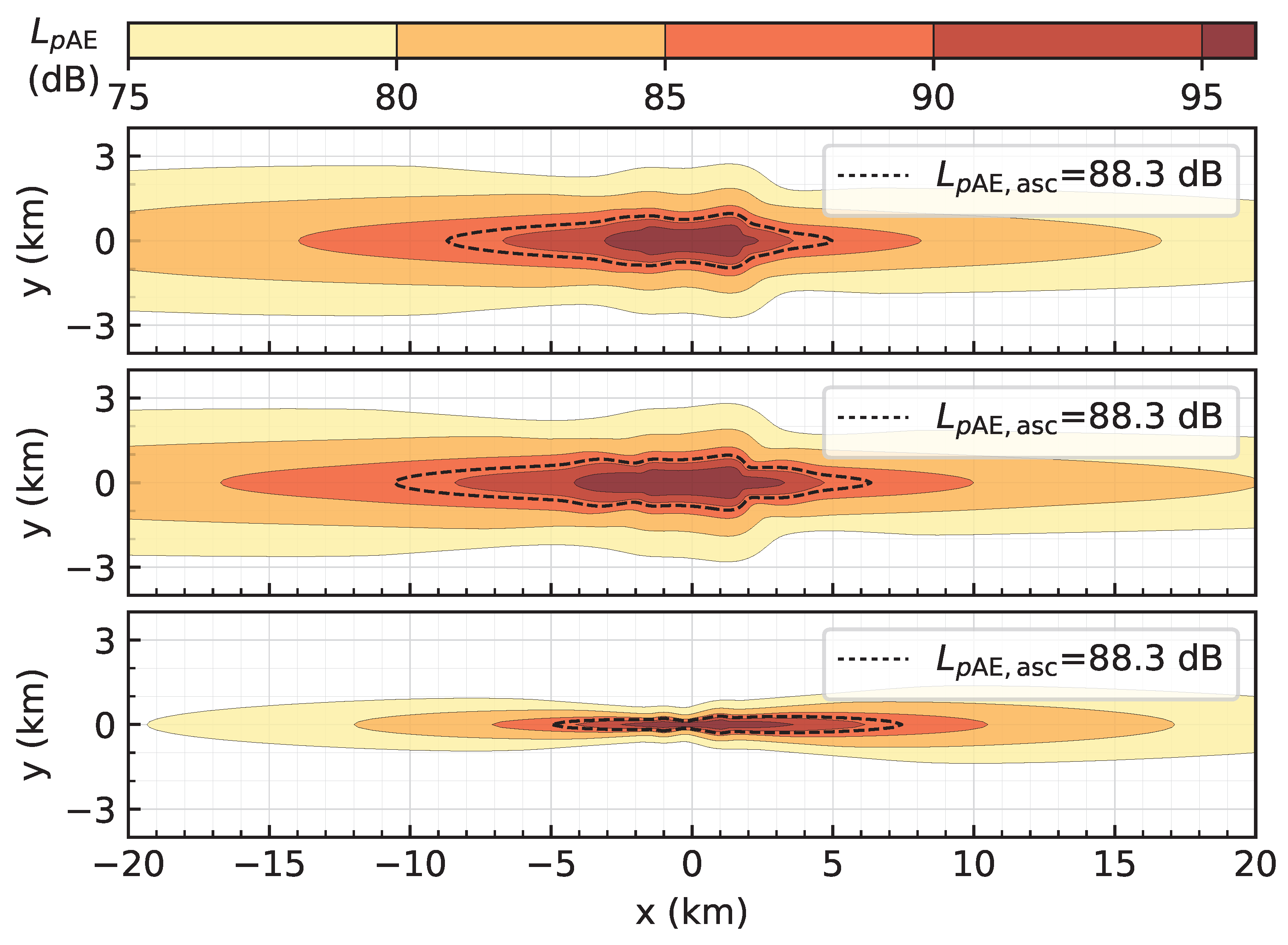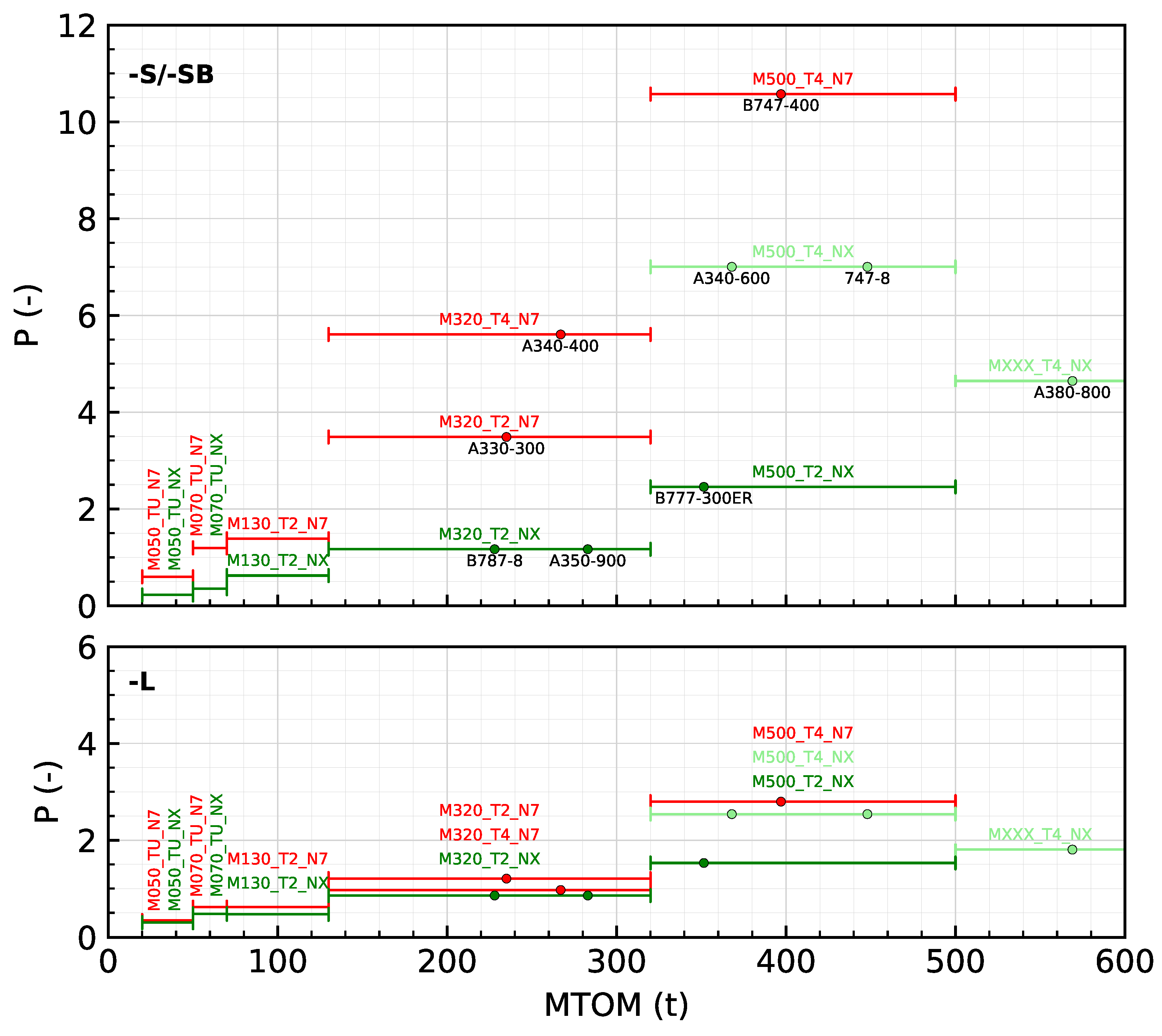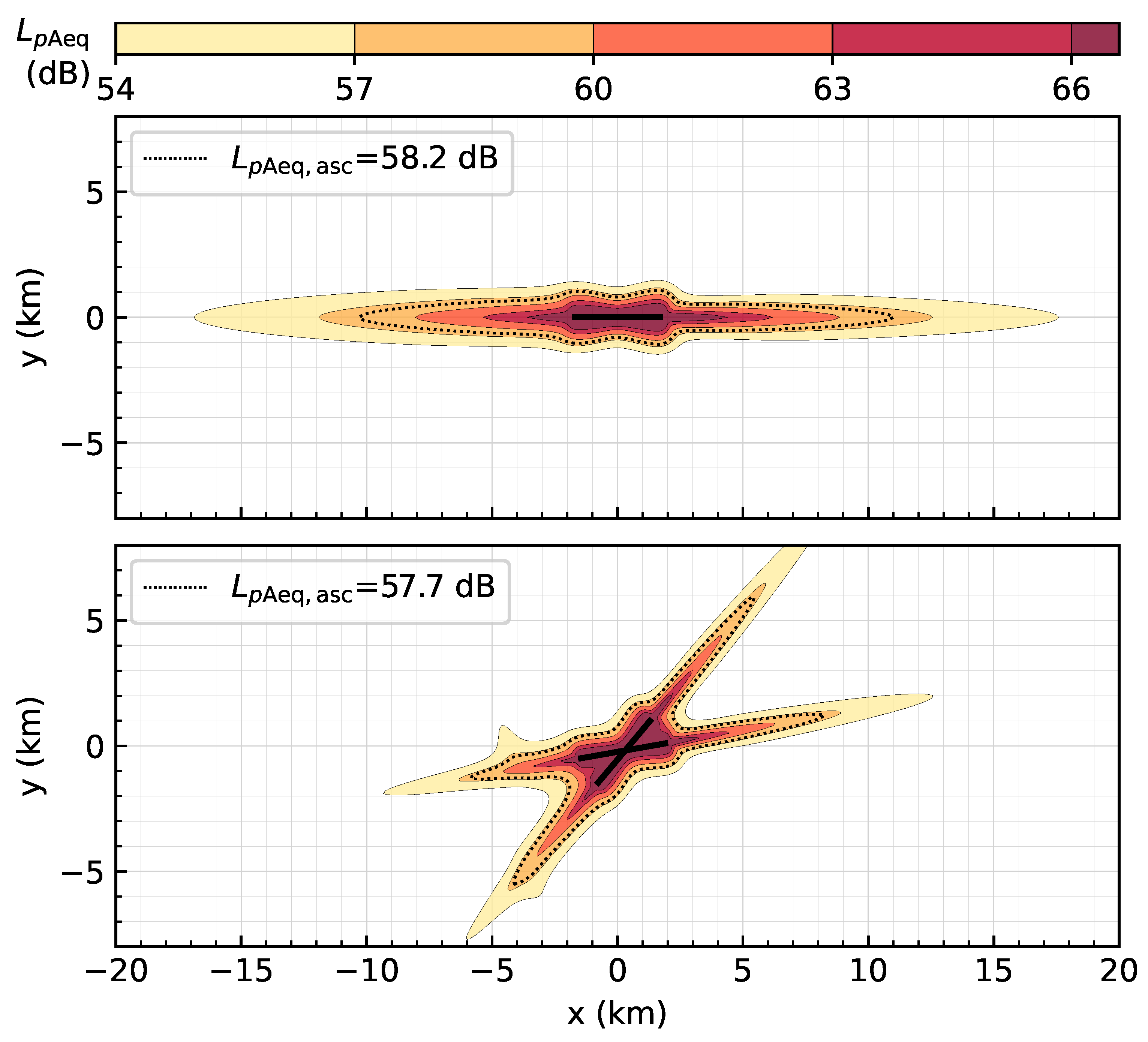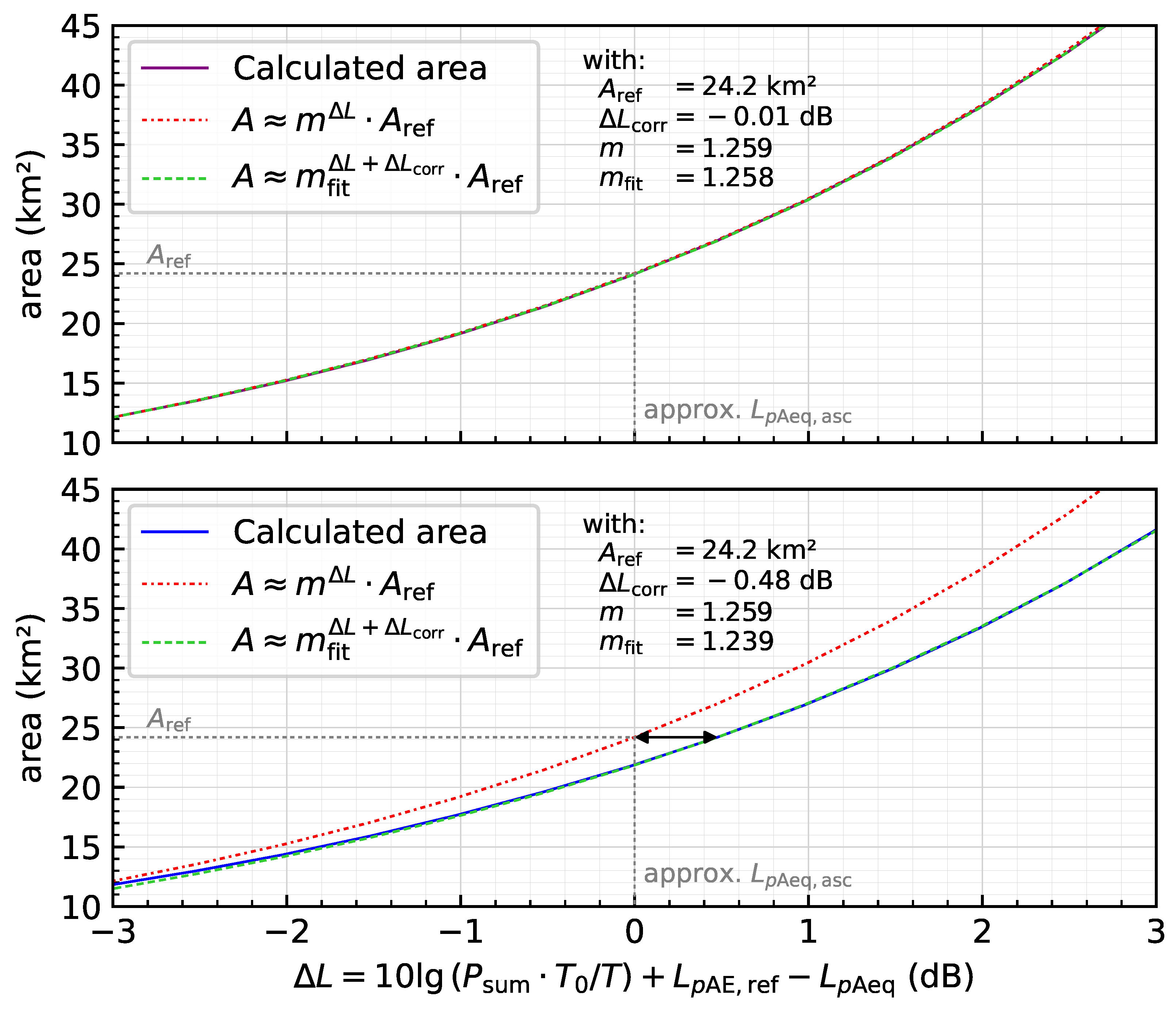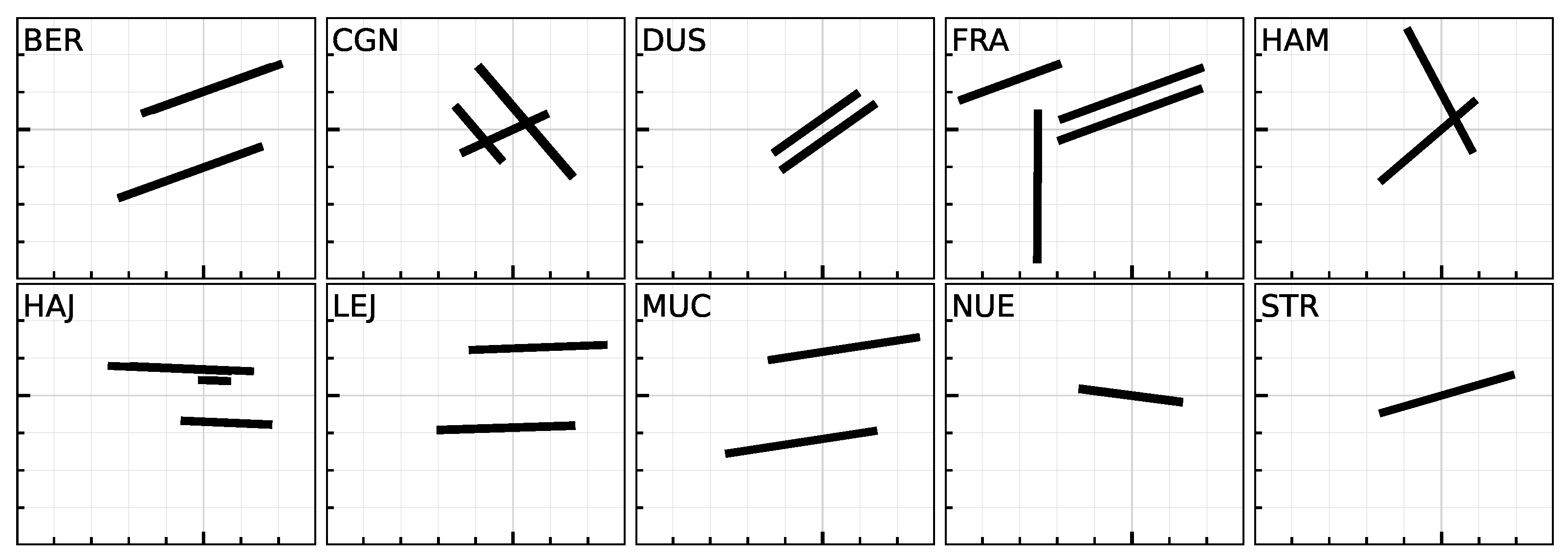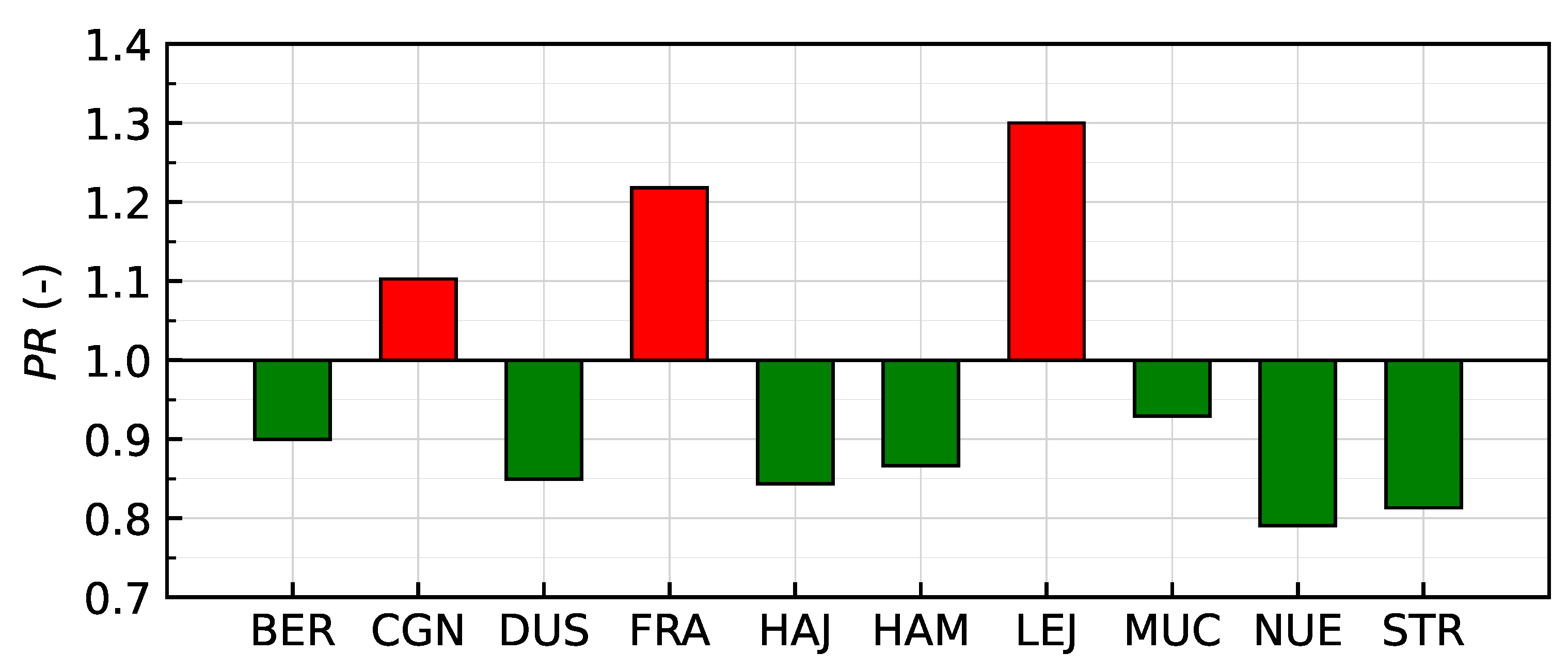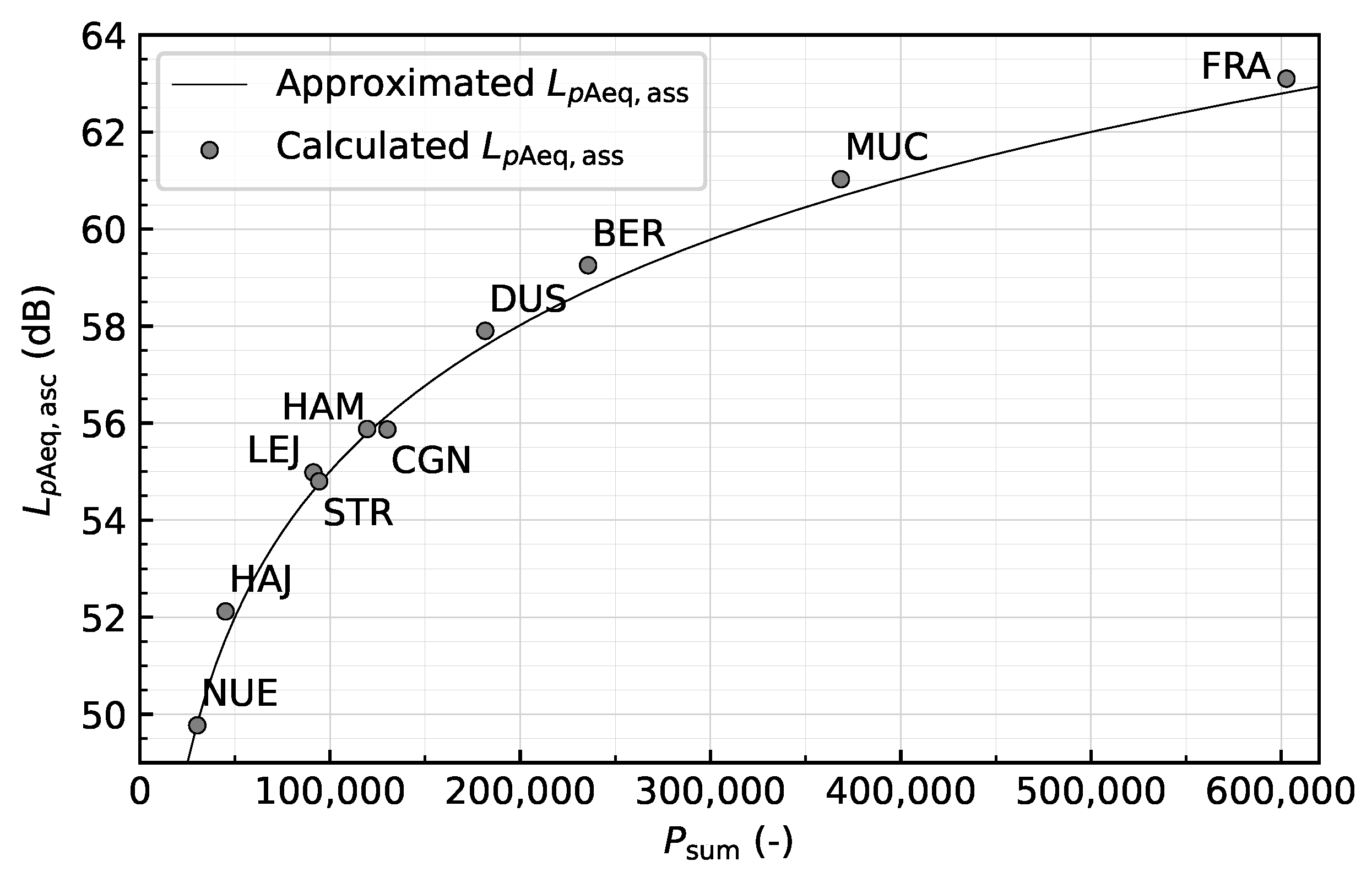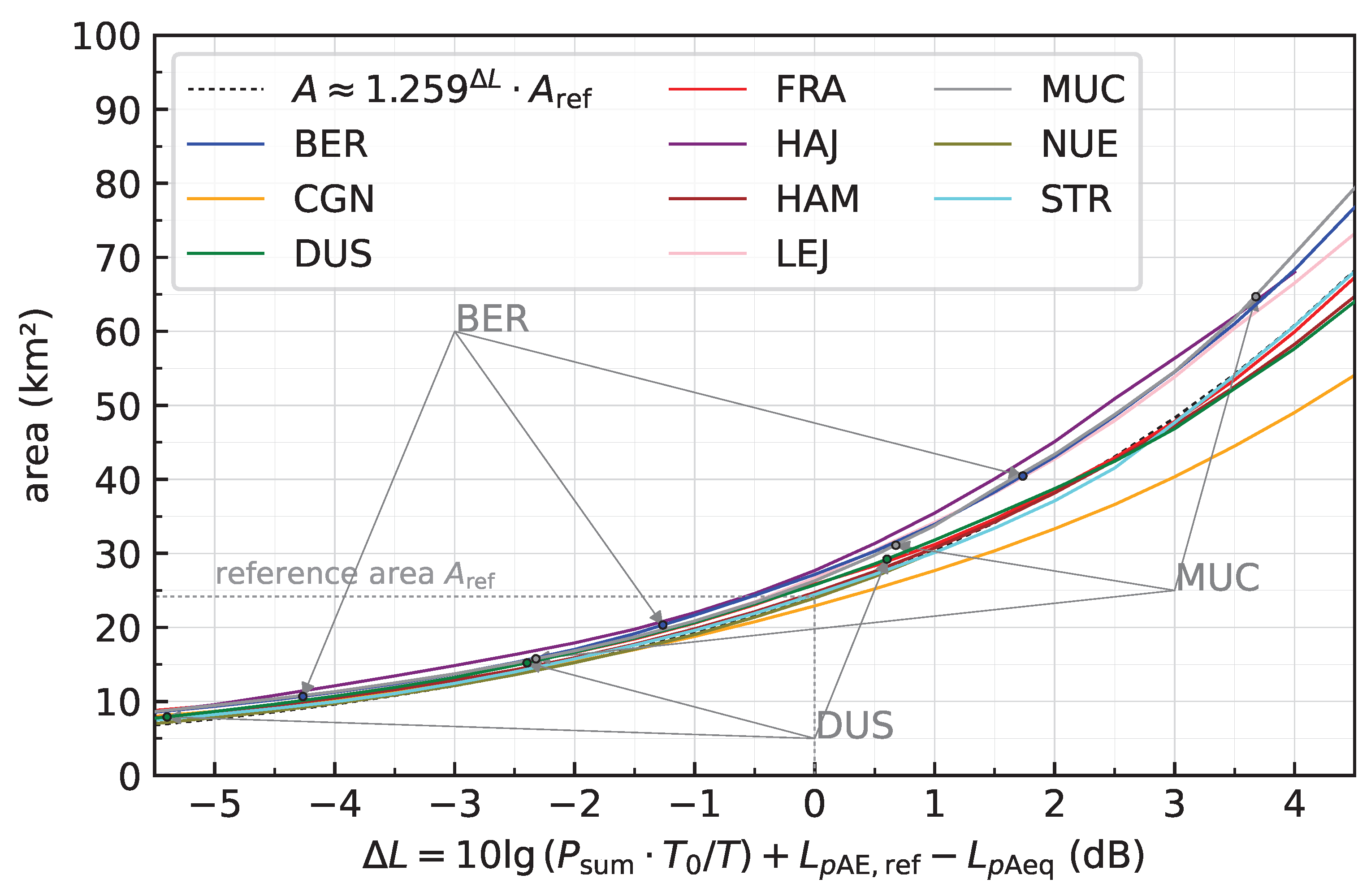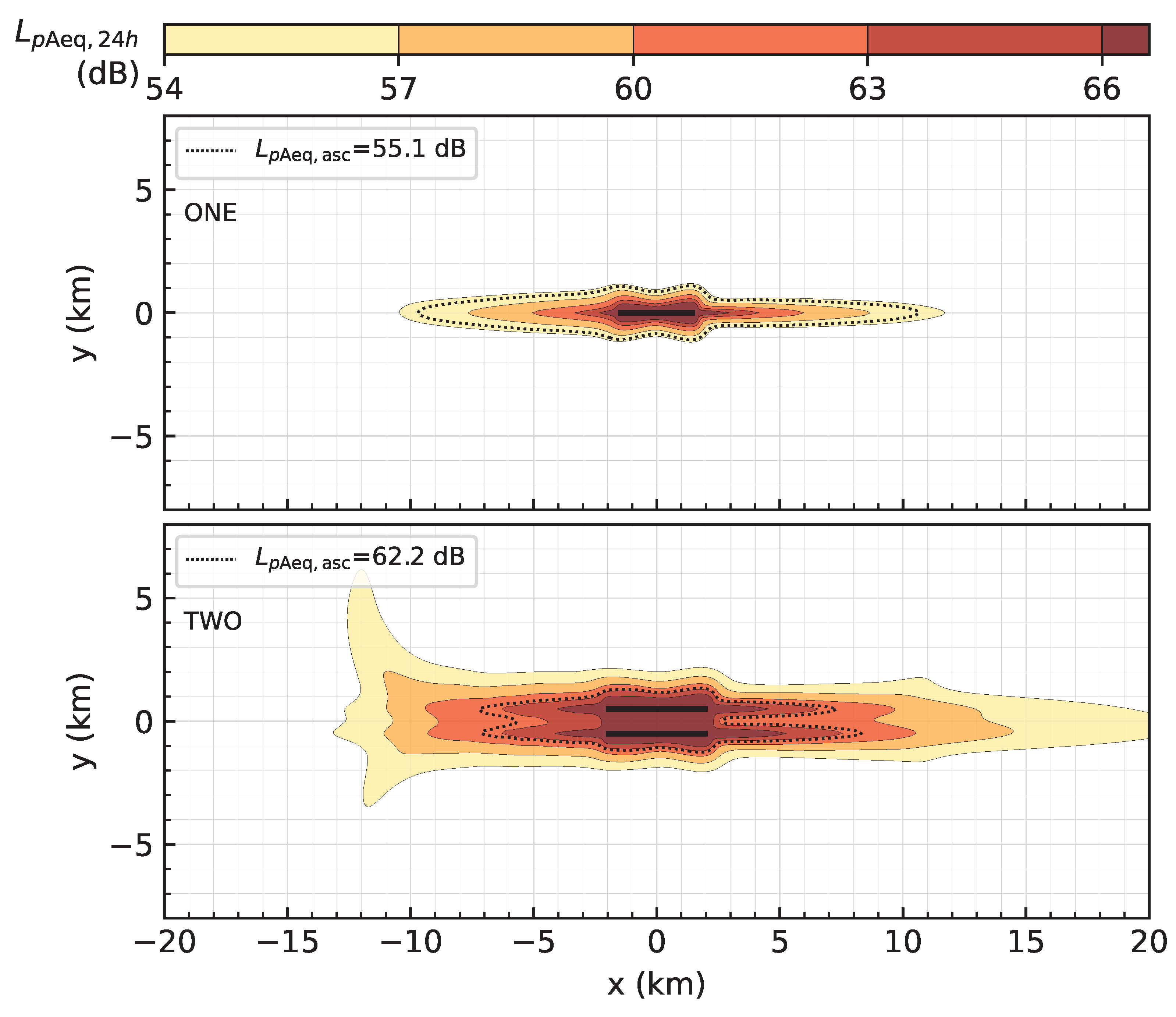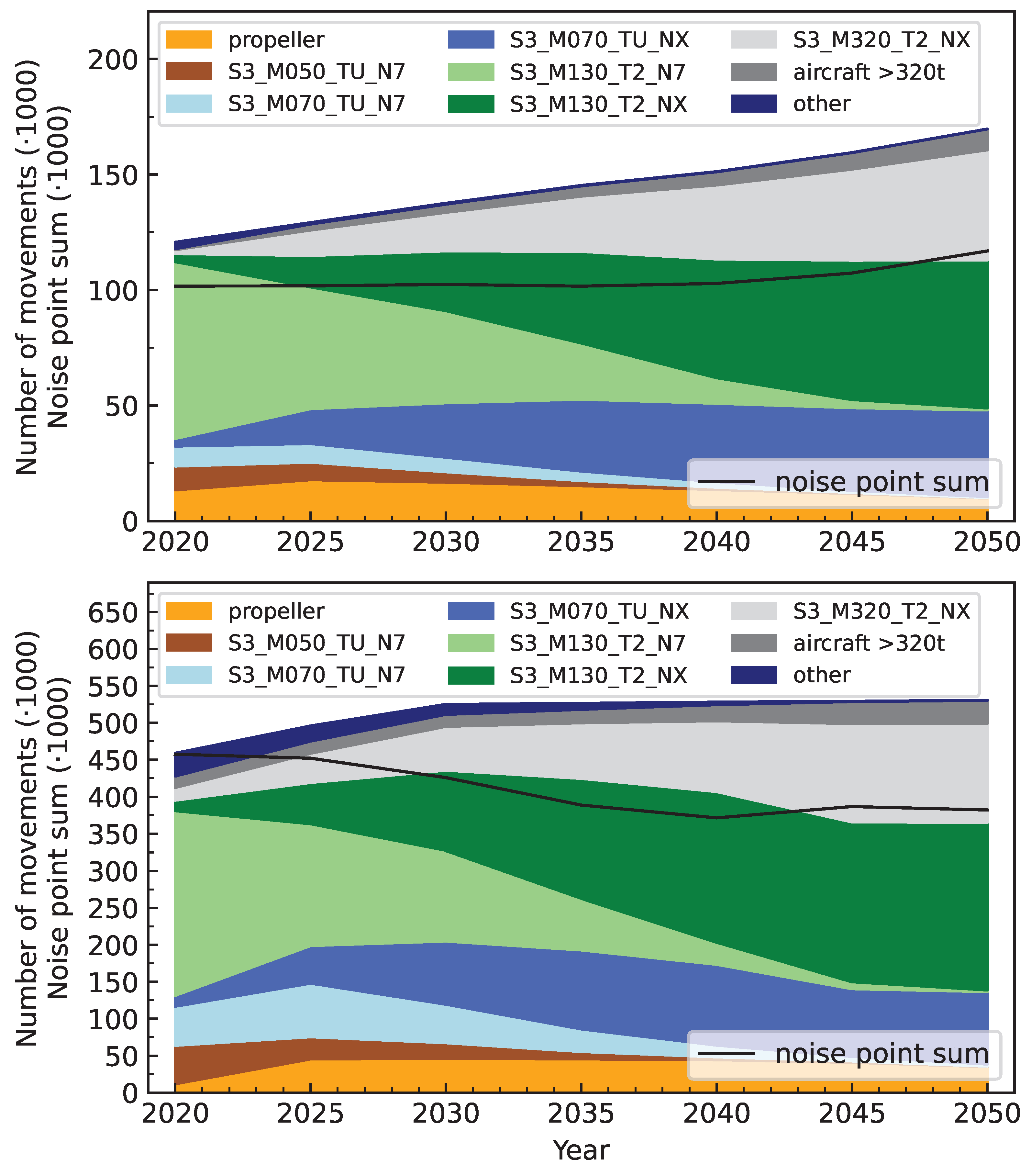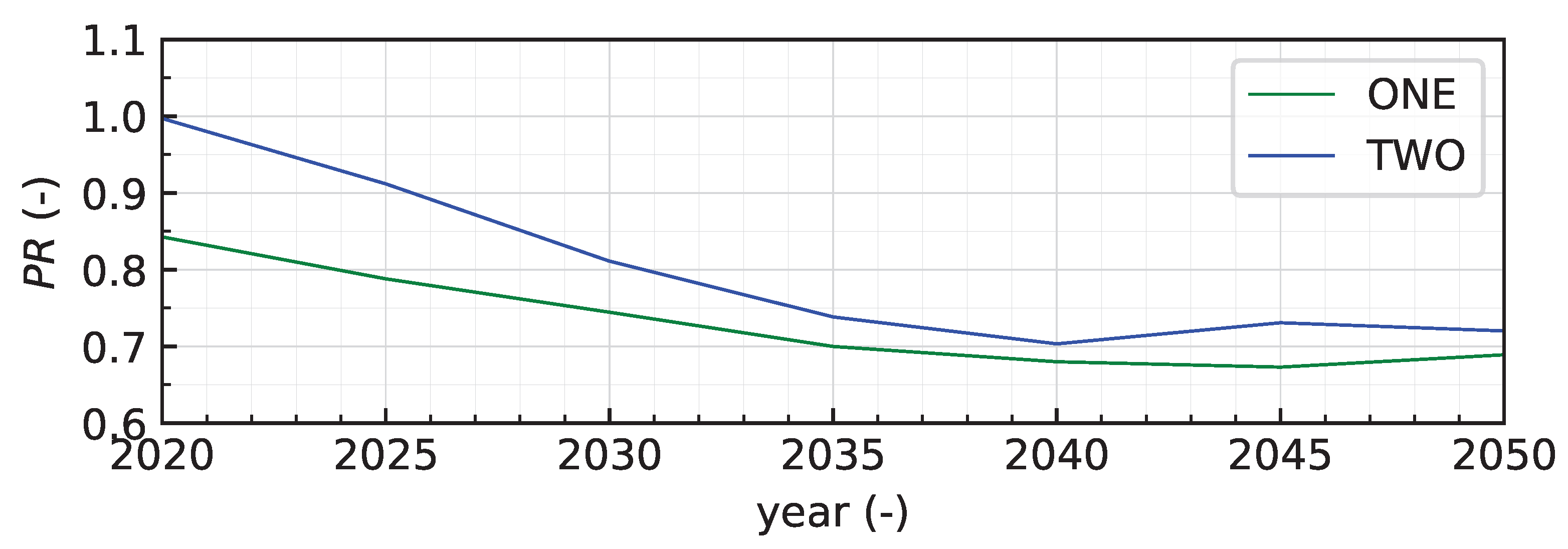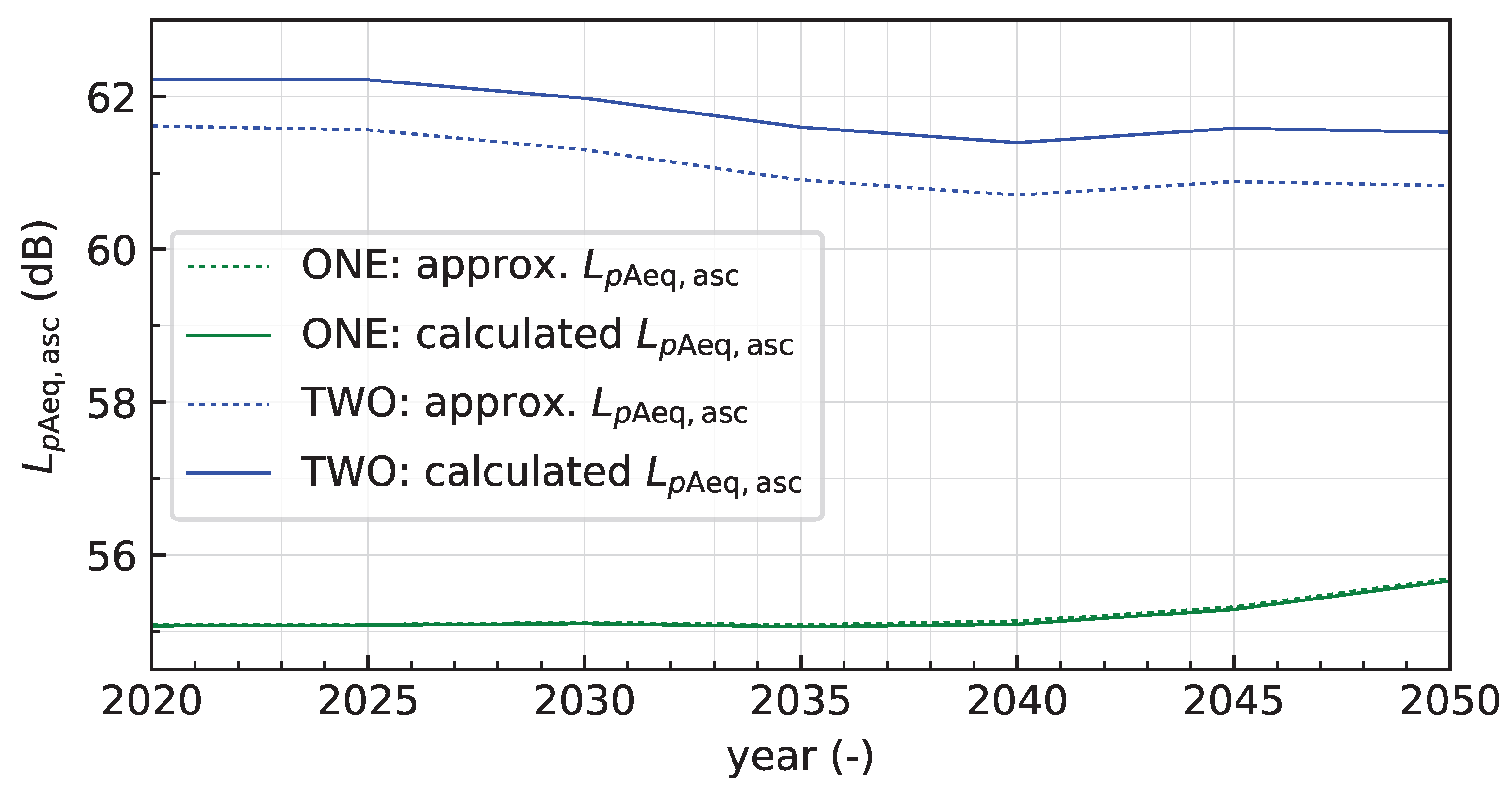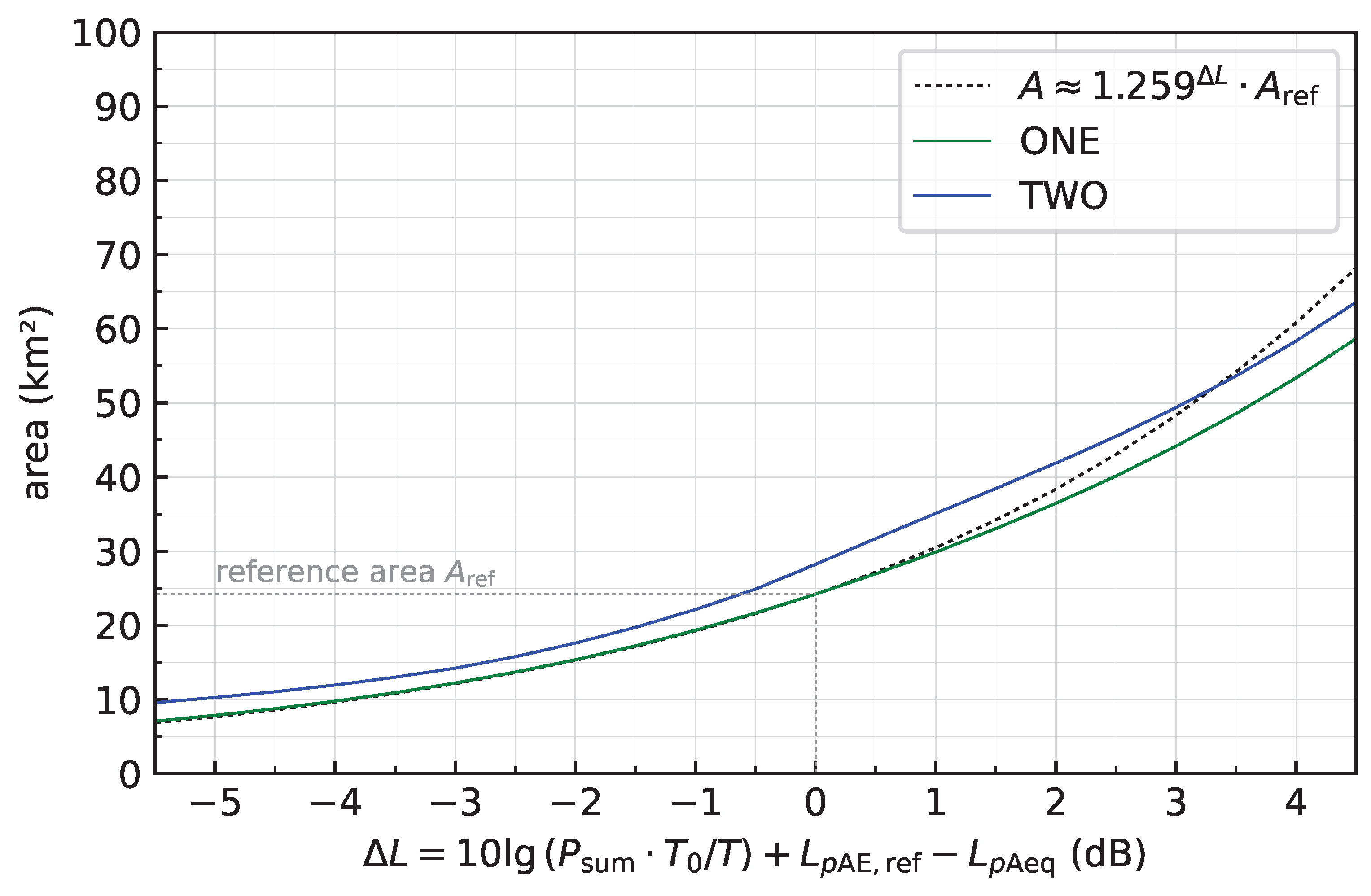In the vicinity of airports, aircraft noise is the most significant environmental problem. This problem is aggravated by the fact that long-term forecasts predict an annual increase in air traffic of approximately 3.6% to 4.2% [
1,
2,
3,
4]. This increase will result in an increase in aircraft movements and/or in aircraft sizes at most airports. This development hampers the fulfillment of ambitious noise goals and recommendations, such as 65% noise reduction compared to the capabilities of typical new aircraft in 2000 in Flightpath2050 [
5] or the recommendation of Day–Evening–Night levels below 45 dB by the WHO [
6] for nearby residents. To analyze the development of the aircraft noise situation (note that the term noise situation in this study generally refers to noise in the vicinity of airports. The measurable descriptor depends on the practitioner, e.g., contour area or number of highly annoyed people) globally, national and international airports must be considered simultaneously, which requires comprehensive calculations and extensive and specific input data; see, e.g., [
7].
Most relevant for the development of the noise situation is the development of the number of aircraft movements and the composition of operating aircraft types. Local details, such as route structure or the distribution of operations on routes, play a subordinate role in the analyses of the global development of the noise situation. To achieve noise reductions, it is of decisive importance whether the increase in noise impact due to an increase in aircraft movements and higher aircraft weights can be overcompensated by technical innovations. For this reason, it makes sense to evaluate the development of the aircraft noise situation using the concept of “noise points”. In this concept, each aircraft type is assigned a noise point that adequately describes its noise impact. If the noise points of all aircraft movements at an airport are summed, the resulting value provides a measure of the aircraft noise situation and can describe the development of the noise situation at an airport. The concept can thus be used, for example, to assess the noise development at an airport or to assess the noise of different what-if scenarios. For example, in the projects DEPA 2070 [
8] and the successor DEPA-ext (ongoing) [
9] conducted by the German Aerospace Center (DLR), different aviation scenarios, up to 2070, are analyzed. Among others, these scenarios consider the introduction of innovative technologies and potential bottlenecks, e.g., in production. The impacts on the environment, economy, and society were assessed in DEPA 2070. Additionally, DEPA ext will incorporate the assessment of aircraft noise through the noise point concept. The noise point concept enables a simple evaluation of the long-term development of noise exposure in the vicinity of airports across various potential development pathways without requiring detailed operational input.
Naturally, noise points can be defined in different ways depending on the purpose and scope of applications, as well as the available data. In this study, a method to determine noise points is conceptualized and applied to the proposed aircraft groups of the German AzB method [
10], also known as AzB21 [
11]. The aim here is that the sum of noise points shall adequately represent a selected noise contour area and, more importantly, its development. Ready-to-use tables of noise points are provided for the proposed aircraft groups of AzB21 [
11]. The method can also be applied to other aircraft groups or aircraft types. The application of this concept is demonstrated with different traffic scenarios. The concept is verified by comparing the obtained results of the noise point concept with calculated values from detailed aircraft noise calculations.
1.1. Literature Review
Assigning a value to an aircraft that represents its noise impact is the basis of well-known methods aimed at limiting noise around airports.
A prominent example is the “Quota Count” system at London’s Heathrow, Gatwick, and Stansted airports [
13], which has also been adopted among others at airports in Madrid, Brussels, Aberdeen, and Warsaw. The “Quota Count” system is used to limit noise at night. In the “Quota Count” system, each aircraft is assigned a value according to its certification levels for approach and departure according to
Table 1. The departure level used for this table is an average of the levels at the flyover and sideline certification points, i.e.,
whereas the approach level used for this table is corrected for a smaller propagation distance at the approach certification point compared to the departure certification points by an empirical value of 9 dB, i.e.,
The “Quota Count” provides means of limiting noise impact by specifying an allowed sum, known as the “Noise Quota”. In the case of London’s airports, the “Noise Quota” is specified by the British Department for Transport.
With regard to the study of aircraft noise development, Rhodes and Hopewell [
14] used this quota count classification to study the aircraft noise development at regional airports in the United Kingdom. The basis for this study was the relationship demonstrated therein that the contour area of a continuous sound level is approximately proportional to sound intensity, i.e.,
, where
is the sound exposure level in dB of a single event. Similarly to the “Quota Count” system, this study used the
values at the certification points. For a better representation of the approach operations, a correction of 11 dB was used instead of the correction of 9 dB as used in the “Quota Count” system.
In Denmark, a “TDENL-method” (Total Day Evening Night Level), which consists of “TSEL” levels (Total Sound Exposure Level), has been used for many years in order to ensure that noise developments around an airport do not exceed limits set by the authorities [
15]. The TSEL value for each aircraft is determined via noise calculations within a certain area and energetic summation of the
noise levels for each grid cell
within this area, i.e.,
where
A is the area of one grid cell, and
m
2 is a reference area. The TDENL value of a traffic scenario can then be determined by summing the TSEL values as follows:
where
j refers to an aircraft type, and
N refers to the total number of movements during day (index
D), evening (index
E), and night (index
N). The weighting factors of 3.16 and 10.0 are applied to account for a noise penalty of 5 dB and 10 dB during evening and night periods, as required for the calculation of the Day–Evening–Night level (see, e.g., [
16,
17]). In principle, the development of the TDENL can be used to scale a reference LDEN-calculation and corresponding contours.
Within the DLR-project FluiD-21 [
12], the noise impact of three transport policy measures was investigated. These measures were as follows: (1) movement limits, (2) weight limits, (3) technical restrictions, and combinations of these. In order to investigate the effect on noise impact, two simple noise point definitions were also analyzed. In the first variant, the noise points
were defined for each aircraft as the ratio of an
contour area to the contour area of a reference aircraft, i.e.,
In the second variant, the noise points
were formed from the arithmetic mean value of the
at three selection emission points and a corresponding reference value of a reference aircraft, i.e.,
where the parameter
q is ultimately set to 3 so that two movements of one aircraft type are equivalent to one operation of an aircraft that is 3 dB louder. The noise points were applied at three generic airports. This showed that the sum of those noise points, which were determined on the basis of the contour areas (first variant
A), represents the development of the
dB contour area well. An in-depth verification or adjustment of the noise points based on real airports did not take place in this study. These noise points were also applied by Grimme and Schmid [
18] at the Amsterdam-Schiphol Airport but not compared with a detailed noise calculation. Within the DLR-project DEPA 2070 [
8], the method of Schmid et al. [
12] was refined, and its was applicability checked against detailed noise calculations at 10 airports.
For the approximation of changes in contour areas, the Federal Aviation Administration (FAA) developed the Area Equivalent Method (AEM) [
19]. This method assists in determining the need for a detailed noise calculation for an Environmental Impact Statement (EIS), i.e., if the approximated change in contour area as determined with AEM exceeds 17 %, an EIS is required. The AEM is based on contour area approximations for each aircraft type (approach and departure combined) via
where
a is the contour area of a single movement, and
b is a scaling parameter that specifies the change in contour area relative to the number of movements
N for this aircraft. With these approximations, the change in the contour area of a traffic scenario can be estimated. However, the use of this method requires permission from FAA’s Office of Environment and Energy.
1.2. Objective of our Work and Outline
Noise point methods are often based on an assumption about the growth of contour areas with increasing noise levels. Even if not stated explicitly, the noise point definition typically already implies such an assumption. A well-known non-analytical, i.e., empirical, relation is that contour areas grow by about 20% if noise increases by 1 dB (see, e.g., [
11]). In this study, the objective is to develop a method of determining noise points that does not require this sort of assumption. Only when explicitly approximating contour areas is such an assumption introduced and analyzed in detail.
The presented study is based on data from the German “Instructions on the Calculation of Noise Protection Areas” (AzB) [
10] (with a proposed revised data basis [
11], known as AzB21), which is described in
Section 2. In
Section 3, the methodology of determining noise points is described thoroughly. The determination of the noise point sum and corresponding derived quantities for traffic scenarios, e.g., contour areas, are then described in
Section 4. One key aspect of this publication is that ready-to-use tables are provided for the AzB21 aircraft groups. With these provided noise points, traffic scenarios and noise developments at all airports can easily be assessed. Finally, the application of the noise point concept is demonstrated in
Section 5. By comparing approximations with calculated results, the concept is verified.
